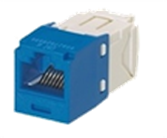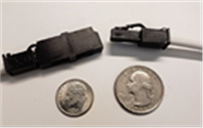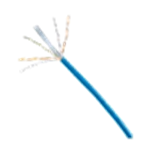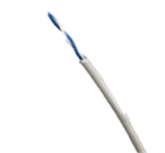Cisco Catalyst 9000 with Panduit Cables Ready for Wi-Fi 6 and Beyond White Paper
Available Languages
Bias-Free Language
The documentation set for this product strives to use bias-free language. For the purposes of this documentation set, bias-free is defined as language that does not imply discrimination based on age, disability, gender, racial identity, ethnic identity, sexual orientation, socioeconomic status, and intersectionality. Exceptions may be present in the documentation due to language that is hardcoded in the user interfaces of the product software, language used based on RFP documentation, or language that is used by a referenced third-party product. Learn more about how Cisco is using Inclusive Language.
Wi-Fi networks are being used for a large variety of applications and are ubiquitous in Enterprise Networks. While people still enjoy using Wi-Fi for the wireless network access it provides, it has also been used for new technologies, such as Internet everywhere, the Internet of Things (IoT), medical and healthcare uses, building automation systems, and offloading cellular onto Wi-Fi. With both the popularity and use-cases of Wi-Fi increasing, a fast and reliable wireless network is a hard requirement for commercial builds. A slow or unreliable wireless network can lead to both reduced productivity and unhappy customers or employees. A fast and reliable wireless network is a key requirement for any deployment.
This white paper describes cabling best practices for Cisco Wi-Fi and switching deployments to support the requirements of both today and tomorrow.
Ethernet Industry solutions supporting Wi-Fi
Wi-Fi speeds and capabilities continue to increase with each iteration of the 802.11 standard. Requirements are increasing not only for bandwidth, but for power as well. Four main technologies are typically used in Wi-Fi deployments today.
10GBASE-T
10GBASE-T, or 10 Gigabit Ethernet, is the best future-proof solution for new Wi-Fi deployments. It is an industry standard solution that allows for data rates of up to 10 Gigabits per second (Gbps) and will be able to support both existing and future Wi-Fi technologies. It can cover up to 100 meters over standard Category 6A cabling.
Multigigabit technology
IEEE 802.3bz Multigigabit technology is good for existing applications, enabling users to get 2.5, 5 or 10Gbps data rates from their existing cabling. It allows better user experiences for devices that support Wi-Fi 6 and 802.11ac Wave 2. Cisco Catalyst switches support 802.3bz standard that allows for up to a fivefold jump in wireless speeds, up to 10 Gbps, on existing Category 5e and 6 cabling, surpassing previously achievable speeds.
Power over Ethernet
Power over Ethernet (PoE) is a common industry technology that enables power and data over a single ethernet cable. There are several different types of PoE. The early PoE standards, IEEE 802.3af and 802.3at, provided data at 1 Gbps and power up to 30W. In 2011, Cisco pioneered Universal Power over Ethernet (Cisco UPOE), providing power up to about 60W and up to 10 Gbps of data when used with multigigabit ports. Finally, following 2018 updates to the IEEE 802.3bt standard (4PPoE), Cisco 90W UPOE+ switches are capable of providing 90W per port. Cisco UPOE+ is combination of the IEEE 802.3bt standard plus Cisco UPOE, which means Cisco switches are in complete compliance with the 802.3bt standard and also support all previous IEEE standards and Cisco UPOE.
A comparison of the PoE standards is given in Table 1.
Table 1. Comparison of PoE standards
| Type |
Standards |
Maximum current |
Number of energized pairs |
Power at source |
Power at device |
Maximum data rate |
| PoE |
IEEE 802.3af |
350 mA |
2 |
15.4W |
13W |
1 Gbps |
| PoE+ |
IEEE 802.3at Type 2 |
600 mA |
2 |
30W |
25.5W |
1 Gbps |
| PoE++ |
IEEE 802.3bt Type 3 IEEE 802.3bt Type 4 |
600 mA 960 mA |
4 |
60W 99W |
51W 71W |
10 Gbps |
| Cisco UPOE |
600 mA |
4 |
60W |
51W |
10 Gbps |
Category 6A cabling
Category 6A cabling is the highest-performing type of copper cable available on the market. It has a bandwidth of 500 MHz and is designed to support data transmission up to 10 Gbps at channels up to 100 meters in length, whereas Category 5e and Category 6 cables are not designed, specified, or recommended for 10 Gbps of data. Many Category 6A cables also provide PoE benefits over prior Ethernet cables with larger wire gauges and cable constructions that encourage better heat dissipation when bundled.
Customer challenges with Wi-Fi deployments
Creating a fast and reliable Wi-Fi network
A fast and reliable Wi-Fi network is a business requirement. A slow office Wi-Fi can lead to unproductive and frustrated employees. Slow Wi-Fi in a more public setting such as a mall, restaurant, or airport can lead to frustrated customers who may choose to take their business elsewhere. Wi-Fi deployments can also be challenging to design – with issues that include weak signals due to walls and other objects, contention from neighboring access points, and the need to design a network that can accommodate all the demands expected like the need to provide an ethernet cabling infrastructure capable of supporting these Wi-Fi bandwidth and reliability on it, both for today and tomorrow.
Designing a cabling infrastructure to support Wi-Fi today and tomorrow
Figure 1 shows the Wi-Fi and enterprise structured cabling standards that have been developed over the past 20 years. As can be seen, there has been little change in structured cabling, whereas Wi-Fi has undergone tremendous change. This is partly due to the nature of the products. People install structured cabling when a building is built and expect it to last for 15 to 20 years, whereas Wi-Fi access points are easier to periodically upgrade.
Hence, a major challenge for Wi-Fi deployments is how to design the structured cabling infrastructure to last 15 to 20 years.
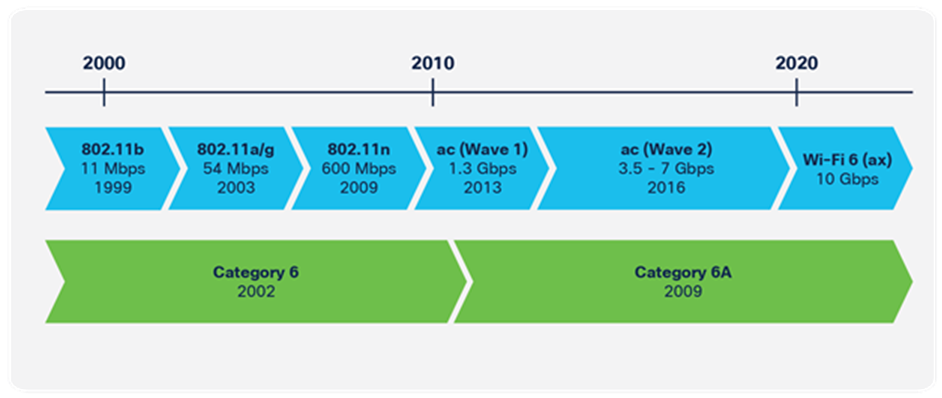
Comparison of standards development for Wi-Fi and enterprise structured cabling (Note: Category 8 is not shown, as it is a data center focused standard)
Designing a cabling infrastructure that is cost-effective and scalable
It is important to note that the cost to install cabling is always lowest during the initial buildout of an office or building. Laying cabling at later stages is often substantially more expensive and difficult.
When designing a cabling infrastructure, it is important to understand where the Wi-Fi standards are going and where they have been. The proposed IEEE 802.11 industry standard states that in some cases two Category 6A cables are needed for optimal performance. Today people are still primarily using Wi-Fi 5 and 6, but consider the next 5 to 10 years and next-generation wireless standards.
Table 2 compares the relevant facts about the Wi-Fi standards for planning a cabling infrastructure. As can be seen, density with the newer Wi-Fi standards is expected to increase, and the data rates needed for them are also expected to increase.
Table 2. Comparison of Wi-Fi standards
| Wi-Fi 4 |
Wi-Fi 5 |
Wi-Fi 6 |
Wi-Fi 7* |
|
| IEEE standard |
802.11n |
802.11ac |
802.11ax |
802.11be |
| Density of access points |
Low |
Medium |
High |
Very high |
| Data rates |
450 Mbps |
1.2 Gbps |
2.5 Gbps |
10+ Gbps |
| Cable |
Cat 6 |
Cat 6A |
Cat 6A |
2x Cat 6A |
Hence, the requirements for cabling infrastructure should:
● Support the Wi-Fi data rates of today and of the future
● Support easy moves, adds, and changes that enable increased density
● Support the Wi-Fi data rates of the future when more than one multigigabit AP ports might be needed
Therefore, you should consider running two to four Category 6A cables per wireless access point where high density is required.
● Day 1: One cable can be used today to support a Wi-Fi 6 access point
● Day 2: Two cables are used to support two Wi-Fi 6 access points for increased density
● Day 3: Two to four cables will be needed to support two Wi-Fi 7 access points (potentially two cables to each access point)
A comparison of the costs of installing the cables in different manners is shown in Table 3. The rough estimate of the cost of installing cable at a later time is 10 times more than the cost of installing it upfront. For example 1, cables are installed as needed, so one cable is installed on day 1, another cable on day 2, and two more on day 3. In example 2, all four cables are installed on day 1. This is the most cost-effective manner to install Category 6A cables to future-proof the installation through Wi-Fi 7 and to address the need for high-density access points as well as the possibility that two Category 6A cables will be needed per access point.
Table 3. Comparison of costs of installing cabling at different times
| Example |
Today |
Day 2 |
Day 3 |
Initial cost |
Upgrade cost |
Total cost |
| 1 |
1 cable |
1 cable |
2 cables |
$x |
$30x |
$31x |
| 2 |
4 cables |
$4x |
$0 |
$4x |
Cisco and Panduit innovation provide performance that exceeds standards today so organizations have the infrastructure in place for tomorrow. We collaborate to maximize network infrastructure ROI through aligned architectures and optimized solutions delivered through an ecosystem of trusted partners.
Cisco Catalyst for WiFi 6
Wi-Fi 6, as the new IEEE 802.11ax standard is an exciting step for wireless and wired LANs. The sixth generation of Wi-Fi not only delivers higher effective speeds, but also enables new business models and use cases, which include full-service provider carrier offload, IT/OT convergence, and real-time applications such as enterprise-grade 4K videos and augmented or virtual reality.
When a higher speed is available on a wireless access point but the switch that the access point connects to is not able to provide higher bandwidth or speed, a bottleneck results, defeating the purpose of having the higher speed at the access point. An oversubscription ratio has been applied to bandwidth from the access layer to distribution and from distribution to core. Once the bandwidth is increased on the access switches, maintaining a similar oversubscription ratio requires switches that are capable of handling it.
The Cisco Catalyst 9000 family of switches and access points can match the oversubscription ratios and can provide even better ratios.
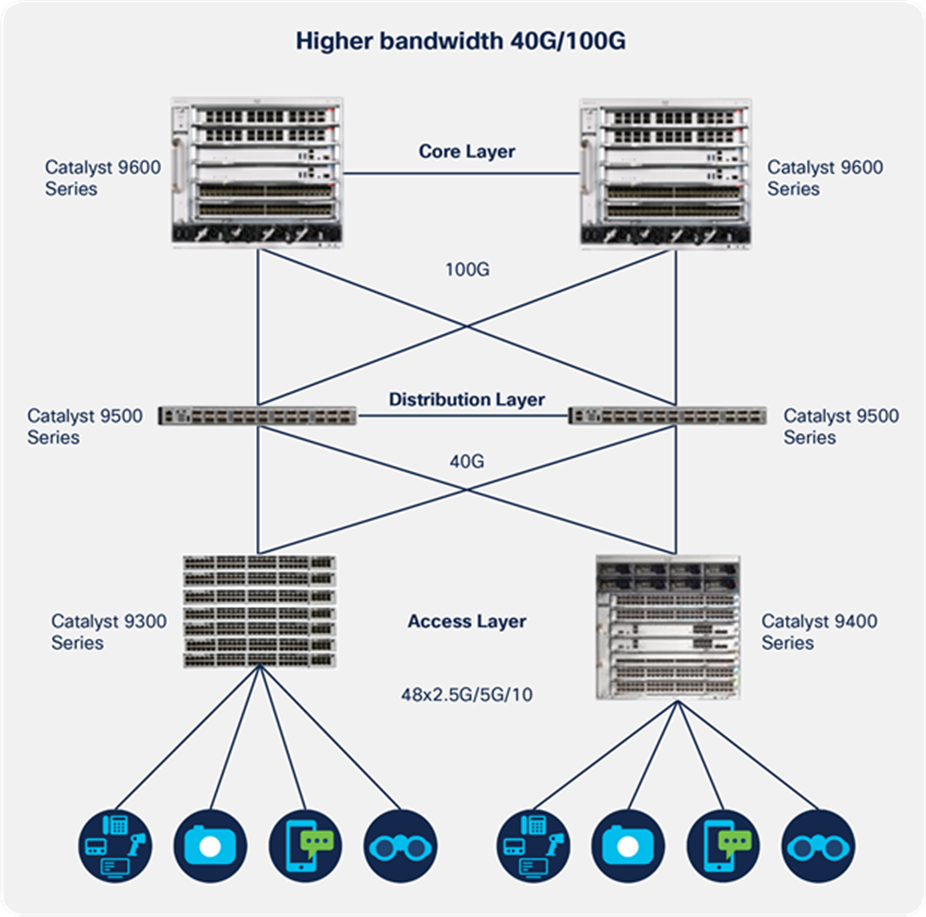
Increased bandwidth between tiers
The Cisco Catalyst 9000 family of access points and switches are ready for Wi-Fi 6.
Catalyst 9000 family of wired and wireless products
Access points and wireless LAN controller
Cisco recently released four different Catalyst 9100 series Access Points (Catalyst 9105AX, 9115AX, 9120AX, and 9130AX Series) along with the Catalyst 9800 series Wireless Controllers, which all support 802.11ax. These Catalyst access points, like the Cisco Aironet 3800 and 4800 Series, have multigigabit ethernet (802.3bz) support. Like Catalyst 9000 switching family, the Catalyst 9100 series Access Points are the first to use the modular Cisco IOS XE operating system. These access points, with 4x4 and 8x8 radio capability, are ideal for any deployment scenario, from small to medium-sized and mission-critical environments.
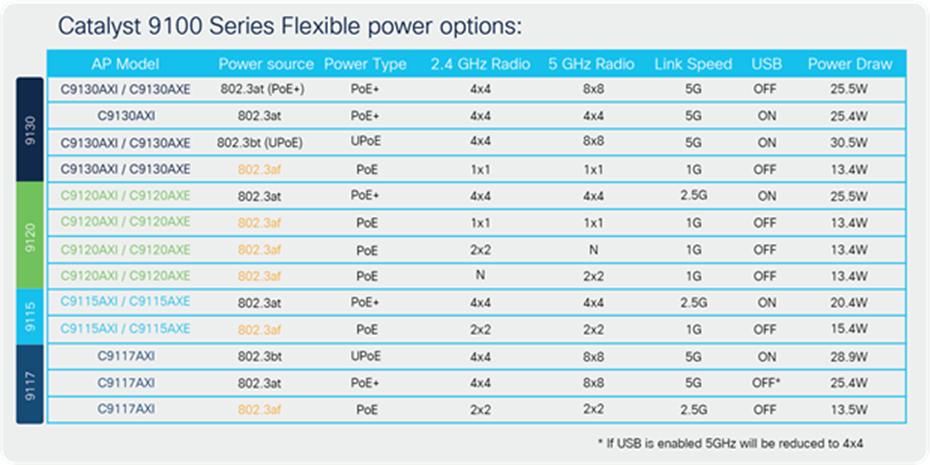
Catalyst 9100 Series access point power options
Figure 4 highlights some of the main features each model is capable of. The Catalyst 9120AX and 9130AX Series are also equipped with a Cisco custom RF ASIC and provide real-time analytics. In high-density scenarios, this custom RF ASIC enables a dedicated third radio, which delivers other features such as rogue detection and RF mitigation.
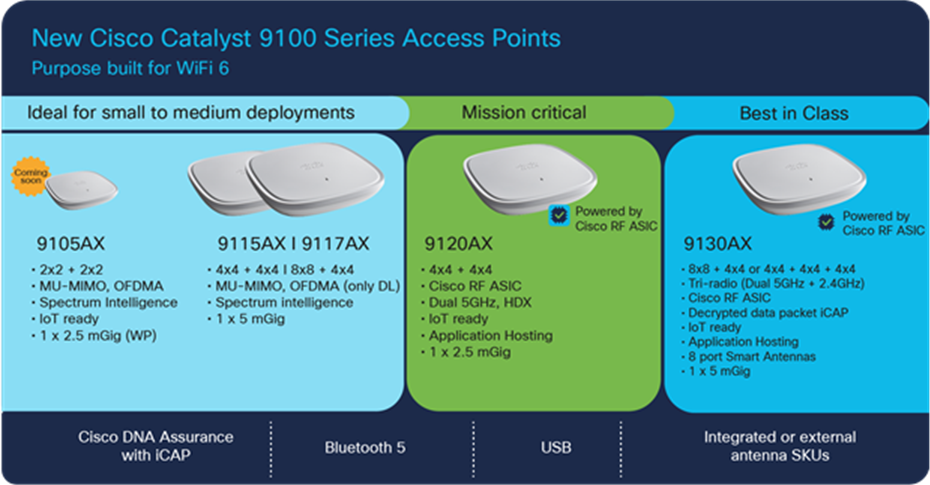
Cisco Catalyst 9100 Series wireless access points
Cisco Catalyst 9000 switching family
The next-generation Cisco Catalyst 9000 switching platforms have a solution for every enterprise use case, from IoT to healthcare environments. With the higher bandwidth required for WiFi 6 at the access points, there will be a need for switching infrastructure that can handle the increased bandwidth. This is where the Cisco Unified Access Data Plane (UADP) ASIC-based Catalyst 9000 switches, access points, and wireless controllers come in. They run on the Cisco IOS XE operating system and provide an end-to-end solution for every use case and environment. Cisco access points, or any multigigabit 802.3bz-capable device, can be connected to a Cisco multigigabit-capable switch port to provide the same amount of bandwidth. The Catalyst 9400 Series, which is built for the access layer, can provide up to 384 copper ports, of which half can be multigigabit ports. All 384 ports can provide up to 90W of PoE as well. Similarly, the Catalyst 9300 Series switches are 1-Rack-Unit (1RU) stackable switches that are specifically designed for the access layer. The 48-port multigigabit models can be stacked and provides up to 384 multigigabit Ethernet ports with 60W of PoE per port. For a smaller installed base that needs multigigabit capacity, the Catalyst 9200 Series stackable switches provide up 12 multigigabit ports per switch plus 30W of PoE per port.
The Cisco Catalyst 9000 switching family can accommodate every type of port density and fulfill the bandwidth requirements for applications that require higher speeds and data rates. The Catalyst 9500 Series offers up to 32 ports of line-rate 100G in 1RU, and up to 62 ports with Cisco StackWise Virtual. Catalyst 9600 Series modular switches offer up to 48 ports of 100G and 96 ports of 40G, as well as up to 192 ports of multi-rate 25G/10G/1G fiber, 1G fiber, or 10G/multigigabit copper. When more PoE is required, the Catalyst 9400 Series with a 90W UPOE+ line card, and the Catalyst 9300 Series 90W UPOE+ models can provide 90W of PoE per port, which enables use cases such as daisy-chaining LED lights to use fewer ports and reduce costs, PoE pass-through by providing more power to the pass-through device for powering more endpoints, USB-C powered devices, digital signage, and medical equipment that needs more PoE.
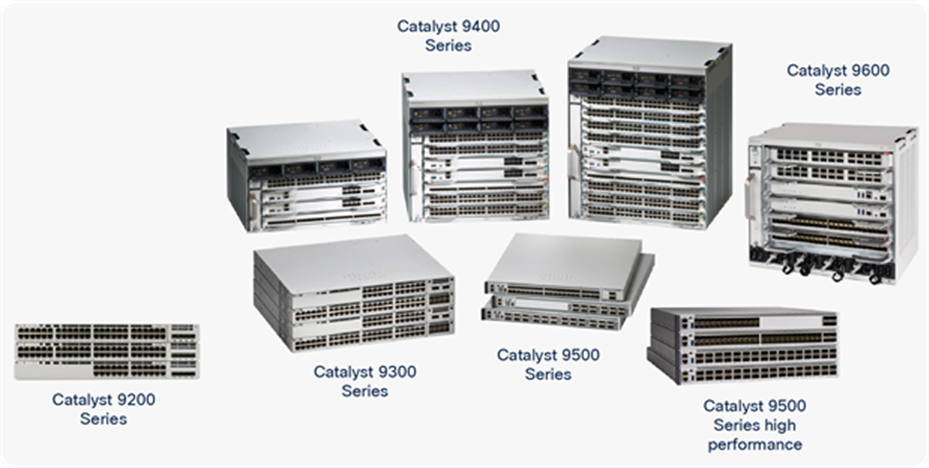
Cisco Catalyst 9000 switching portfolio
Cisco is the industry leader in PoE and Multigigabit technology and over the years Cisco has increased the power and bandwidth from 15W to 30W to 60W and now 90W with the ratification of the 802.3bt standard, and from 100 Mbps to 10 Gbps, allowing for greater port utilization to power laptops, monitors, phones, lights, and a host of other devices. Today, different technology, such as lighting and video surveillance, can run on one platform, combining IT and OT onto one platform. The only way to connect all the different devices is for everyone to follow one standard.
Cisco is working with Panduit and many other manufacturers to make sure the devices work properly over a PoE infrastructure. In addition to the densest architecture for PoE, Cisco created an intent-based network software architecture to manage thousands of endpoints while maintaining a strong security posture.
Cisco has recently introduced a new PoE analytics capability in its Cisco DNA-Center Assurance that help in identifying the overall PoE visibility of the entire network, with troubleshooting options that enable easy fixes with just a few clicks. With Cisco DNA Center version 2.1, four Dashlets have been added: PoE Powered Device Distribution, Power Load Distribution, PoE Insights, and PoE Operational State Distribution (Figure 6).
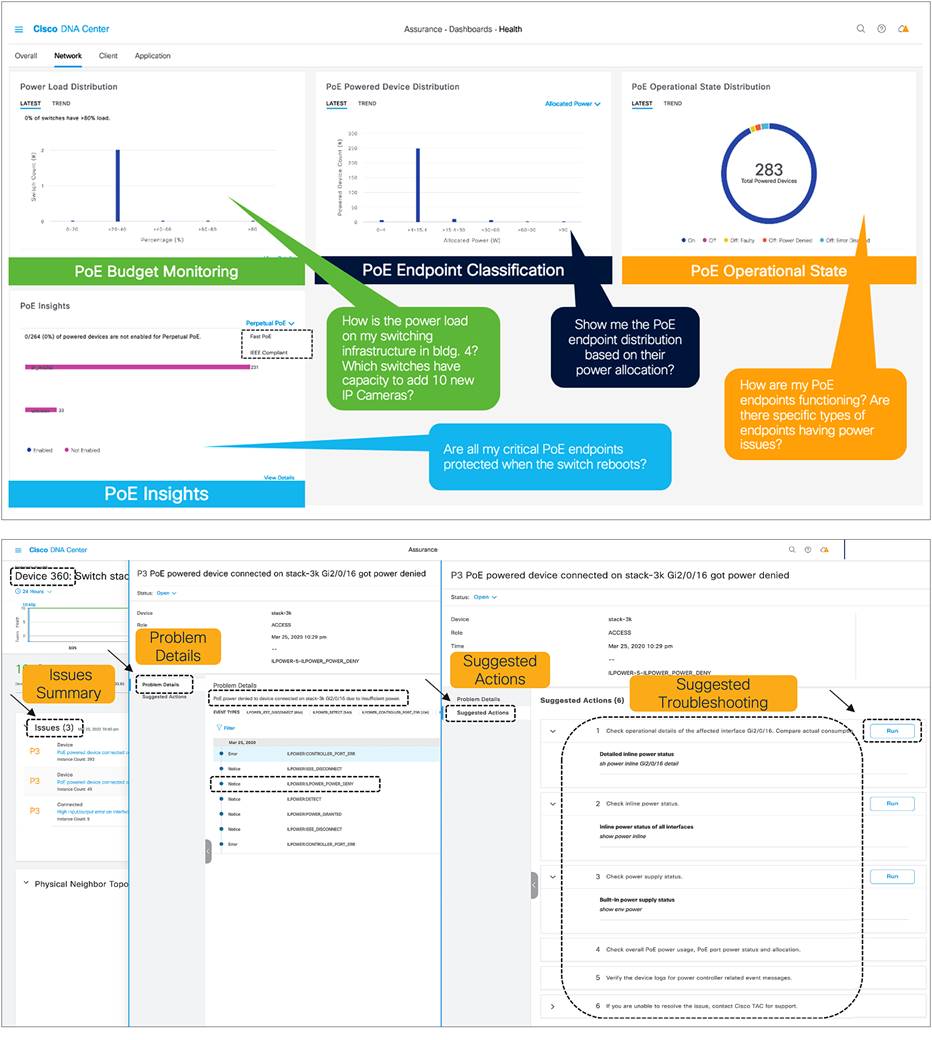
PoE Analytics dashboard and Device 360 troubleshooting
Panduit and Category 6A cables for WiFi 6
Panduit offers the industry-leading Category 6A solution. This solution focuses on having the premier solution in all elements of the deployment, from cable performance to installation and usage over time.
The Vari-MaTriX cable is the most advanced Category 6A cable available on the market, with features such as:
● Smallest Category 6A cable in the industry at a 0.250inch diameter, simplifying pathway design and upgrading from older categories
● Full 100-meter 23 AWG solution
● Uses a unique discontinuous metallic foil with variable cuts (cut separation distance is random) to minimize noise from external sources
● Ideal for PoE, as discontinuous metallic foil limits rises in cable bundle temperature
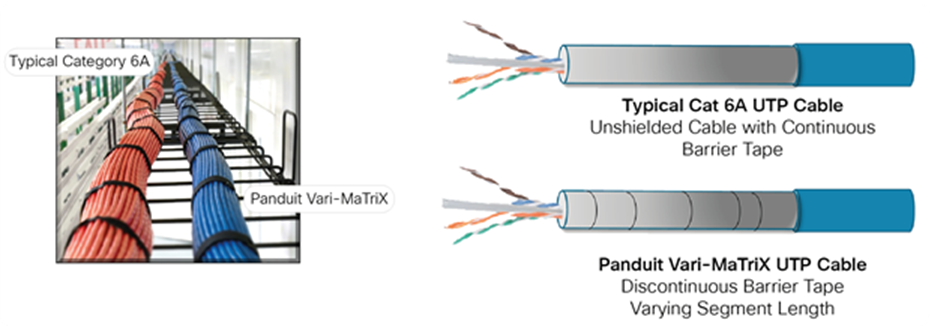
Panduit Vari-MaTriX cable offers unsurpassed performance in a small footprint
As seen in Figure 7, cables are often deployed in large bundles. When these cables are carrying PoE, the overall heat of the bundle can rise, particularly in the center of the bundle. The new PoE standard makes this more of a concern, as there is significantly more power.
The Vari-MaTriX cable is ideal for PoE usage, as it helps dissipate heat better than both older cable categories such as 5e and 6 as well as typical Category 6A cables. This improved heat dissipation is due to the 23 AWG conductors and the foil around the cable. The metallic foil helps remove heat from the center of the bundle to limit heat rise. Figure 8 shows how the heat rise for the Vari-MaTriX cable is lower than for typical Category 6A cables and older categories for larger and larger bundle sizes.
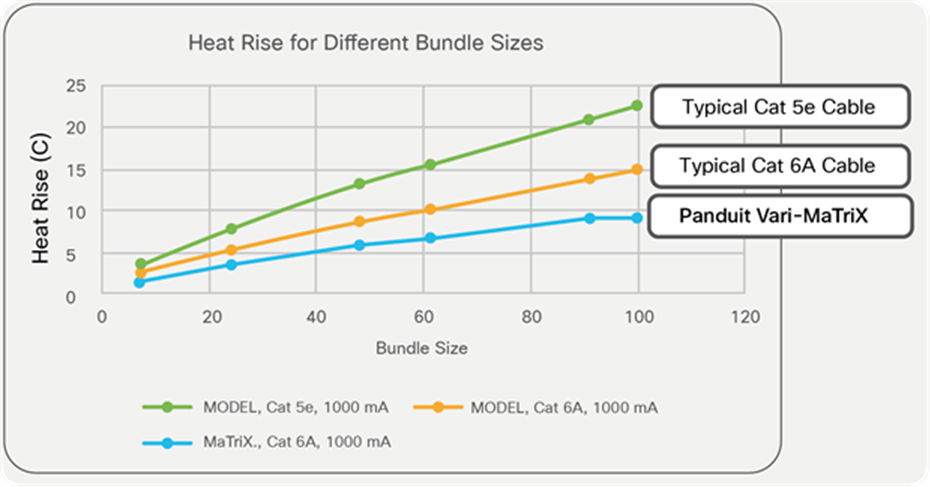
Panduit’s Vari-MaTriX cable has the lowest heat rise when running next-generation PoE
The Panduit TX6A Field Terminable Plug (Figure 9) is a plug that can easily terminate to any cable and offer up to Category 6A performance. Older plug designs were designed for factory termination and could work only on very specific cable types. The Panduit field terminable plug works with almost any standard category cable. It includes features such as:
● Ability to terminate a standard Category 5e to 6A cable type
● Up to Category 6A performance (when attached to a Category 6A cable)
● Saves time and money on deployments by reducing both labor and material costs
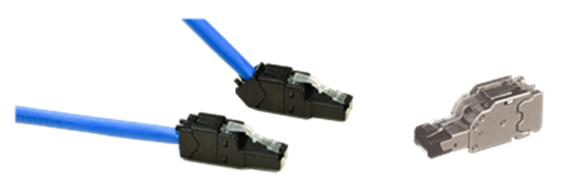
Panduit TX6A Field Terminable Plugs are ideal for connecting to wireless access points
End-to-end drawings of Wi-Fi 6 deployments
Wi-Fi 6 deployment with Catalyst 9300 Series switch
Figure 10 shows a distributed deployment with the infrastructure products necessary to complete the installation of a Catalyst 9300 Series switch to a Catalyst 9130AX Series access point. Table 4 shows the Panduit parts used in the deployment. Table 5 shows the Cisco parts used.
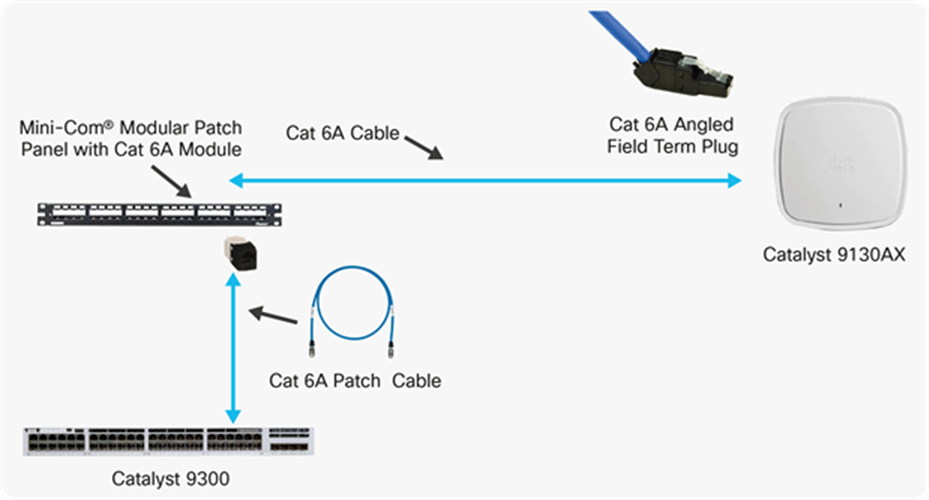
Wi-Fi 6 deployment with a Catalyst 9300 Series switch and Panduit infrastructure products
Table 4. Panduit unshielded and shielded parts used in the Wi-Fi 6 deployment with the Catalyst 9300 Series switch
| Type |
Panduit part description |
Part number |
| Unshielded |
24-Port Patch Panel |
CPP24FMWBLY |
| Cat 6A Jack Module |
CJ6X88TGBU |
|
| Cat 6A Patch Cord |
UTP28X3BU |
|
| Cat 6A Flame Rated Patch Cord |
Depends on region, see Table 9: Panduit copper flame-rated patch cords |
|
| Cat 6A Horizontal Cable |
Depends on region, see Table 8: Panduit copper horizontal cables |
|
| Angled TX6A Field Term Plug |
FPUD6X88MTG |
|
| Shielded |
24-Port Patch Panel |
CP24BLY |
| Cat 6A Jack Module |
CJS6X88TGY |
|
| Cat 6A Patch Cord |
STP28X1MBU |
|
| Cat 6A Flame Rated Patch Cord |
Depends on region, see Table 9: Panduit copper flame-rated patch cords |
|
| Cat 6A Horizontal Cable |
Depends on region, see Table 8: Panduit copper horizontal cables |
|
| TX6A Field Term Plug |
FPS6X88MTG |
Table 5. Cisco parts used in the Wi-Fi 6 deployment with the Catalyst 9300 Series switch
| Type |
Part number |
| Catalyst 9300 Series switch |
C9300-48UN |
| Catalyst Access Point |
Catalyst 9130AX |
Wi-Fi 6 deployment with Catalyst 9400 Series switch
Figure 11 shows a distributed deployment with the infrastructure products necessary to complete the installation of a Catalyst 9400 Series switch to a Catalyst 9130AX Series access point. Table 6 shows the Panduit parts used in the deployment. Table 7 shows the Cisco parts used.
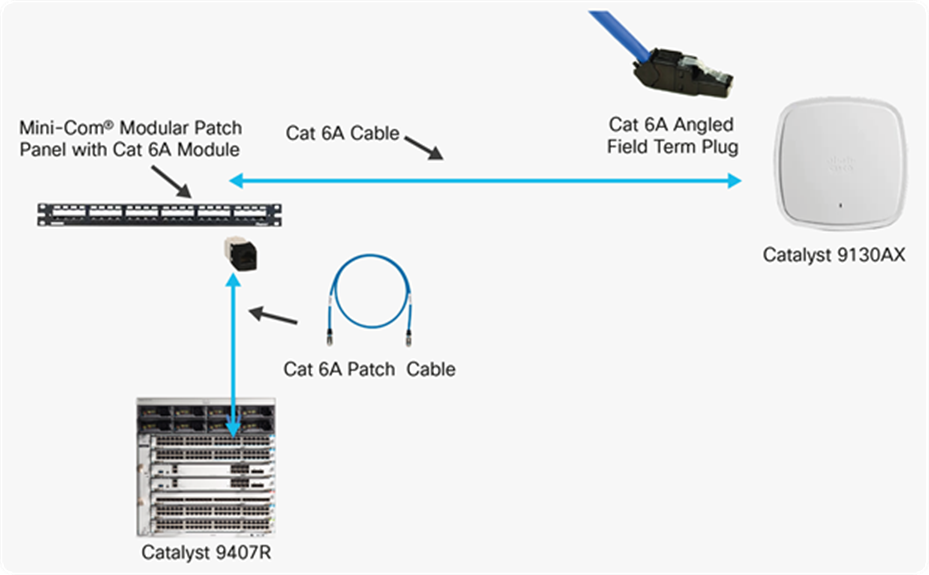
Wi-Fi 6 deployment with the Catalyst 9407R switch and Panduit infrastructure products
Table 6. Panduit parts used in the Wi-Fi 6 deployment with the Catalyst 9400 Series switch.
| Type |
Panduit part description |
Part number |
| Unshielded |
24-Port Patch Panel |
CPP24FMWBLY |
| Cat 6A Jack Module |
CJ6X88TGBU |
|
| Cat 6A Patch Cord |
UTP28X3BU |
|
| Cat 6A Flame Rated Patch Cord |
Depends on region, see Table 9: Panduit copper flame-rated patch cords |
|
| Cat 6A Horizontal Cable |
Depends on region, see Table 8: Panduit copper horizontal cables |
|
| TX6A Field Term Plug |
Straight: FP6X88MTG / Angled: FPUD6X88MTG |
|
| Shielded |
24-Port Patch Panel |
CP24BLY |
| Cat 6A Jack Module |
CJS6X88TGY |
|
| Cat 6A Patch Cord |
STP28X1MBU |
|
| Cat 6A Flame Rated Patch Cord |
Depends on region, see Table 9: Panduit copper flame-rated patch cords |
|
| Cat 6A Horizontal Cable |
Depends on region, see Table 8: Panduit copper horizontal cables |
|
| TX6A Field Term Plug |
Straight: FPS6X88MTG |
Table 7. Cisco parts used in the Wi-Fi 6 deployment with the Catalyst 9400 Series switch
| Type |
Part number |
| Catalyst 9400 Series switch |
C9407R; C9400-LC-48UX; C9400-SUP1-XL |
| Catalyst Access Point |
Catalyst 9130AX |
Table 8. Panduit copper horizontal cables
| Category 6 |
Category 6A |
|||
| Unshielded |
Shielded |
Unshielded |
Shielded |
|
| Plenum (CMP) |
PUP6C04BU-U |
PFP6C04BU-UG |
PUP6AV04BU-G |
PFP6X04BU-UG |
| Riser (CMR) |
PUR6C04BU-U |
PFR6C04BU-UG |
PUR6AV04BU-G |
PFR6X04BU-CG |
| CM |
PUC6004BU-FE |
PFC6004BU-G |
PUC6AV04BU-G |
PFC6X04BU-CEG |
| EuroClass Cca |
PUY6004WH-HE |
PSY6C04WH-CED |
PUY6AV04WH-EG |
PUFY6X04WH-HED |
| EuroClass Dca |
PUL6004WH-FE |
Refer to Cat 6A |
PUL6AV04WH-EG |
PFL6X04WH-CEG |
| LSZH |
PUL6004WH-FE |
PFL6004BU-G |
PUL6AV04WH-EG |
PFL6X04WH-CEG |
Table 9. Panduit copper flame-rated patch cords. While most patch cords are CM rated, the ones in this table can be used when required for a specific area (for example, a patch cord to be placed in a plenum air space)
| Category 6 |
Category 6A |
||
| Unshielded |
Unshielded |
Shielded |
|
| Plenum (CMP) |
UPPBU* |
UZPPBU* |
SAPPBU* |
| Riser (CMR) |
UPRBU* |
UZPRBU* |
SAPRBU* |
| CM |
UTP28SP*BU |
UTP28X*BU |
STP28X*BU |
| EuroClass Cca |
UPDWH*M |
UZPDWH*M |
(Nonstandard) |
| EuroClass Dca |
UPLWH*M |
UZPLWH*M |
SAPLWH*M |
| LSZH |
UTP28SP*MBU |
UTP28X*MBU |
STP28X*BU |
Wi-Fi and PoE
This document has already mentioned several of the exciting new elements coming with Wi-Fi and PoE. While Wi-Fi 6 is the best Wi-Fi standard currently available, the 802.11be standard (we’ve assumed that it will be called Wi-Fi 7) is under development and is expected to launch in the 2023 and 2024 timeframe.
The next-generation 802.3bt PoE standard has been ratified, and products using this standard are currently being deployed. This new standard is ideal for technologies such as next-generation wireless access points that are assumed to have a higher power draw and higher data rate needs that the new PoE standard can supply. This standard is also expected to see a lot of new devices come onto the network due to its higher power capabilities.
Single Pair Ethernet
Single Pair Ethernet is a new technology under development that is expected to be used in areas like industrial automation and building automation. Table 10 compares a traditional network done with 4-pair cable and with Single Pair Ethernet. As can be seen, Single Pair Ethernet operates at a much lower data rate but can go much further distances. It is believed that this data rate and distance coverage will be better suited for these new areas.
Table 10. Traditional Ethernet versus Single Pair Ethernet.
| Parameter |
Traditional Ethernet |
Single Pair Ethernet |
| Data rate |
Up to 10 Gbps (10GBASE-T) |
10 Mbps at 1000 m |
| Power levels |
Up to 71W (PoE++) |
7W to 52W, depending on cable length |
| Reach |
Up to 100 m |
Up to 1000 m |
| Connector type |
RJ45
|
Modified LC
|
| RU density |
48 ports in 1RU |
96 ports in 1RU |
| Cable type |
4-pair Category 6 or 6A
|
Single Pair
|
Wi-Fi 6 is a revolutionary new wireless standard that will provide extensive benefits to end users. It offers many benefits, such as faster data rates, lower latencies, and longer device battery life. Further technological advancement in Wi-Fi in the future should also be beneficial for end users. Cisco offers switches and access points that simplify the design, installation, and operation of your network.
The ideal cabling for running Wi-Fi 6 is Category 6A cabling. Panduit offers an ideal Category 6A cabling infrastructure to run Wi-Fi 6. Its unique products, such as the Vari-MaTriX cable, offer the industry’s best PoE performance, all with the industry’s smallest cable diameter. Panduit also offers products such as the TX6A Field Terminable Plug, which simplifies the installation of these wireless access points.
Cisco Catalyst 9000 series switches combined with Catalyst wireless products and Panduit cables are best for Wi-Fi 6. The recommendation of this paper is to consider a Cisco and Panduit validated solution for deploying Wi-Fi 6.
